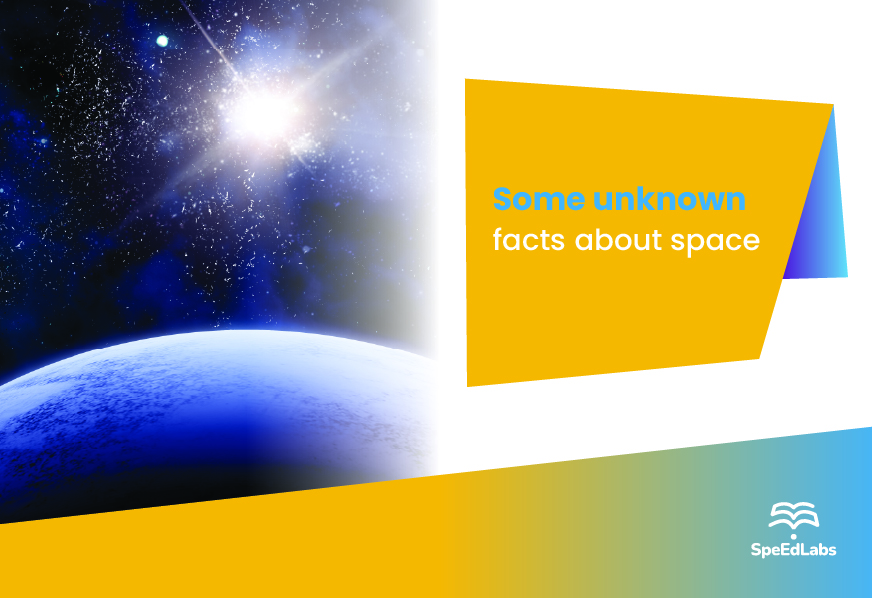The young, curious minds of the digital age are also always intrigued with our universe’s size and facts!
Let’s learn some interesting facts about our universe.
Earth: How big is it?
You are lucky to be born on earth because this is the only planet that supports life fully to date. However, you are not alone on this planet, and there are around 7.9 billion people apart from you, excluding other forms of life like flora and fauna. Ever wondered how big the earth is that provides a home to such a large number of organisms? It is large, but what about outside this planet?
Solar system and facts about space
All of you are already familiar with that we have eight planets in our solar system so let us understand the difference in size with the perspective of a human, earth, and other terms associated with space. It is mind-boggling but very fascinating.
The earth= 3.5 million * human’s size.
The Solar System= 36 billion * earth’s sizes.
The Local Group= 5 million * Solar System. (Our nearby galaxy cluster, the Local Group, consists of at least 47 galaxies, including our own.)
The Virgo Supercluster= 11 * Local Group (the Virgo Supercluster is 110 million light-years wide and comprises around 100 galaxy clusters, similar to our Local Group).
The Supercluster Complex of Pisces-Cetus is 12 times the size of the Virgo Supercluster.
Finally, the Observable Universe dwarfs the Pisces-Cetus Supercluster Complex by a factor of ten.
After reading the numbers above, you must realize how small you are in the observable universe. Moreover, this is just the observable universe. There is also the possibility of many more such Universes, which will combine to produce a new great term of space. Are you interested in knowing more about this massive term-‘space’? Great! In this blog, we’ll talk about some fascinating facts about space that will blow your mind.
Mars sunset appears to be Blue: The fourth planet from the Sun is Mars, and it is the Solar System’s second-smallest planet, only Mercury being smaller. Sunsets on Mars, unlike sunsets on earth, would seem bluish to human spectators observing from the red celestial body, according to NASA. The blue near the Sun’s region of the sky becomes considerably more visible due to fine dust, whereas regular daylight makes the Red Planet’s typical rusty dust hue the most visible to the naked eye.
Experts believe that the footsteps of the Apollo astronauts on the moon will last for at least 100 million years: National Aeronautics and Space Administration’s third human spaceflight program, also known as Apollo mission or Project Apollo. This mission succeeded in training and launching the first humans on the moon from 1968 to 1972. Because the moon lacks an atmosphere, the Apollo astronauts’ imprint will not be destroyed or washed away. It implies that their footprints, prints of the spacecraft will remain for a very long period on the moon. Now you may be wondering how these imprints would disintegrate after 100 million years, considering the moon has no environment? Let us understand this simple concept. The moon is a complex creature. It is routinely bombarded with “tiny space debris,” meaning that erosion on the moon is still occurring, although slowly.
A planet composed entirely of diamonds exists: Let us plan a trip to this planet. After all, you’ll be getting diamonds which costs millions of dollars on our planet. Unfortunately, we can’t go to this planet as it is 40 light-years far away from earth or 380 trillion km which is impossible with today’s technology. Graphite and diamond are most likely present on the “super-earth,” also known as 55 Cancri e. This exoplanet has an estimated mass of 8.63 Earth masses and a diameter of roughly twice that of the earth, making it the first super-Earth identified.
On Venus, a day is longer than a year on earth: Venus is the second closest planet to the Sun. After the Moon, Venus is the brightest natural object in the night sky, with an axis revolution that takes around 243 Earth days to complete one complete cycle. Venus takes 226 days to complete one circuit around the Sun. Because Venus orbits clockwise, the Sun will rise in the west and set in the east here.
Let us look at some more facts that are small yet engaging: The only planet with a density lower than that of water is Saturn. It will float it dropped inside a water body of its size.
Mercury is our solar system’s fastest planet. It travels at a speed of 172,000 kilometers per hour around our Sun. On Mercury, a year is equivalent to 88 Earth days.
Jupiter’s massive sphere could hold almost 1,300 Earths. After all, the world has become a small place to live.
One of Jupiter’s four biggest natural satellites is Europa. It’s a bit smaller than the Moon on Earth. Ice covers this moon, including the smooth part, which can develop into an ice-skating rink. Is anyone Interested?
Asteroids are scary, aren’t they? But, even if all of the known asteroids in our solar system were combined, their total mass would be less than 10% of the mass of Earth’s Moon.
Neptune’s massive, whirling storms have the potential to consume the whole earth.
Key Takeaways
So, this was a bit about the space. However, this knowledge is only a smidgeon, similar to your size with the visible cosmos. There are numerous other facts, and you can research them as there are brilliant opportunities in this domain.
Also published on Medium.
